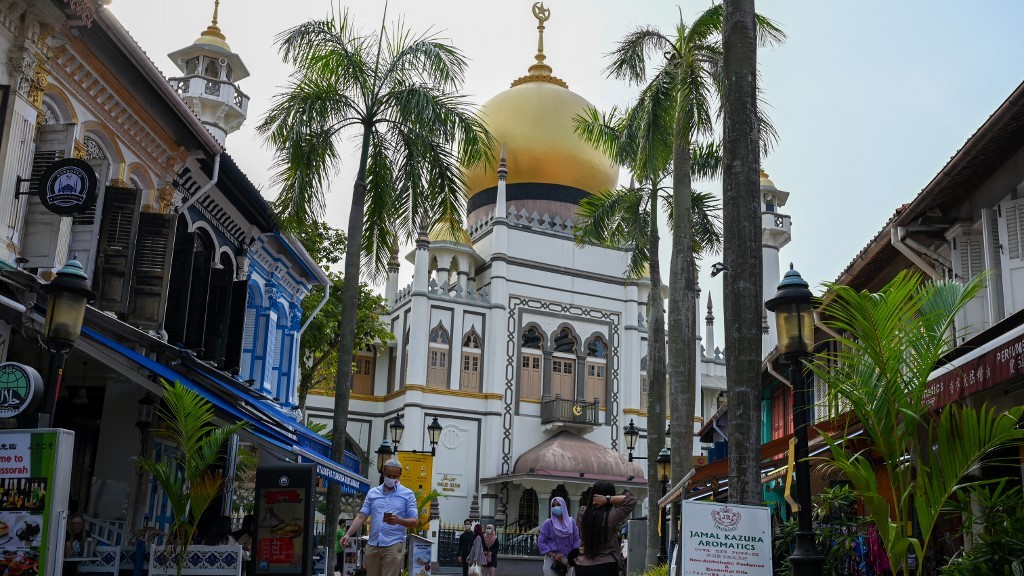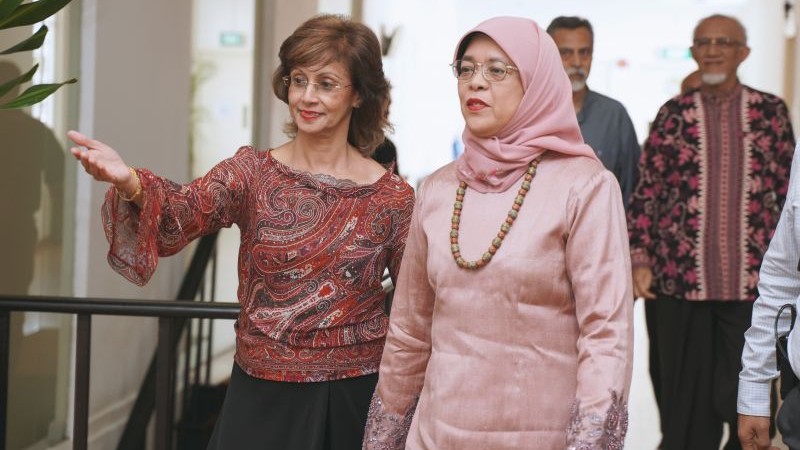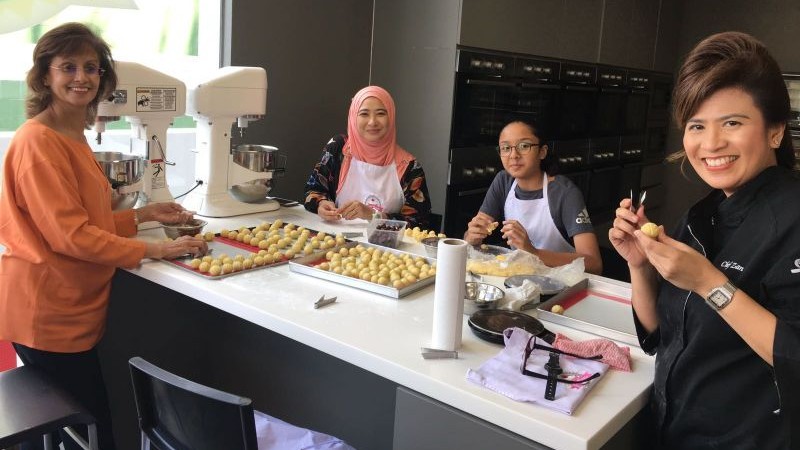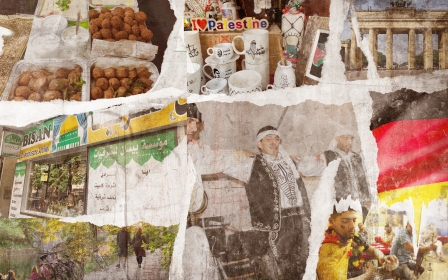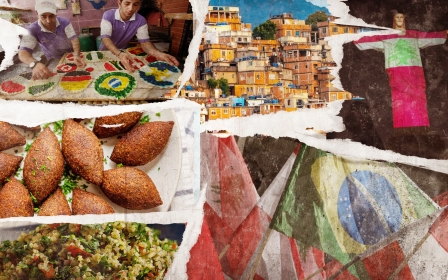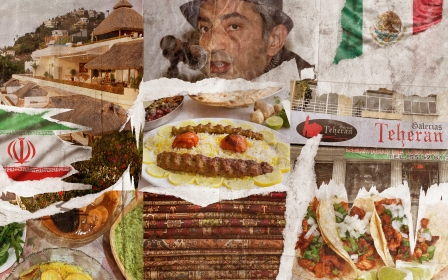Singapore’s Arab Street: A closer look at the community building a new legacy

Walking down the streets of Singapore, the global financial hub known for its rich cultural blend and modern skyscrapers, one comes across a neighborhood that stands out from the rest - the Kampong Glam, aka the Arab Street area.
The streets are lined with colorful shophouses of squat two-storey buildings, with traditional eateries, textile and handicraft shops.
At the heart of this major tourist destination, full of street art, lies the Sultan mosque, with its Indo-Saracenic style and striking golden dome. A key Muslim and cultural enclave, for over a century the area had been a hub for Arab traders and merchants.
The area today bears street names including "Arab", "Muscat" or "Bussorah Street”.
The Arab community has been here for more than 200 years, and was once one of the most affluent immigrant groups in the city, owning large swathes of land.
New MEE newsletter: Jerusalem Dispatch
Sign up to get the latest insights and analysis on Israel-Palestine, alongside Turkey Unpacked and other MEE newsletters
Their many contributions to trade and various other industries have helped Singapore develop into the thriving metropolis it is today.
Arab influence can be seen in the city's food, as well as its places of worship and entertainment.
Here we take a closer look at a community that was for centuries a hub for Arab traders, and how it is being preserved today.
Origins of the Arab community
The first Arabs are believed to have arrived in Singapore in 1819, the same year as Stamford Raffles, the British colonial official considered the modern founder of the city-state.
Many of them came from the Hadhramaut Valley in southern Yemen and are believed to have been Syeds, who claim to be descended from the Prophet Muhammad.
They crossed oceans to migrate to Southeast Asia in the 18th century where they traded various goods, including textiles and spices.
“Raffles invited them to Singapore, which was already a busy seaport, so they could invest there,” Khadija Alattas, the president of the Arab Network @ Singapore (AN@S) tells Middle East Eye.
The Arabs were allocated a place in Kampong Glam, near the Malay Sultan’s Residence, because according to Raffles, "the Arab population required every consideration".
Merchants Syed Mohammed bin Harun Aljunied and his nephew Syed Omar bin Ali were the first to settle in Singapore. The Alsagoffs and the Alkaffs, other wealthy Hadhramis, soon followed.
A thriving community
By 1930, there were 1200 Arabs in Singapore. "Over the years, they acquired large amounts of land until they owned more than half of the territory," Alattas explains.
Arabs did not let their lands go to waste; they developed farms, built shops and owned some of the most prestigious buildings like the Alkaff Mansion or the iconic Raffles Hotel.
Considered a national monument, it is recognised for being founded in 1887 by the Sarkies brothers, Armenian luxury hoteliers hailing from Iran.
What is less known however is that the property was owned by the Alsagoff family who leased it to the Sarkies.
According to author Gretchen Liu, the Alsagoffs were not involved in running the hotel but “they invested in the property and presumably paid for the expansion," she tells Middle East Eye.
They had a supportive role: “They hired the best architects, and it was the first building in Singapore to have electricity,” Liu adds.
They were so prominent that in 1938, while on a visit to Egypt, one of the Alsagoffs was received by King Farouk I.
“Descendants of Arab families are still very proud of their heritage, and rightly so. They were super wealthy and cosmopolitan in their day,” Liu says.
The disintegration of Arab wealth
However, the affluence did not last.
In 1939, the colonial government introduced rent controls, and after Singapore's independence in 1965, the Land Acquisition Act allowed the government to acquire land for housing and development projects from private individuals at “below-market value”.
By the end of the 1980s, the government had become the largest landowner while Arabs saw the value of their lands vanish.
Alattas, a descendant of the Alsagoff family from her mother's side, experienced this loss firsthand.
She was born near the Arab neighbourhood in a compound of eight to ten bungalows where her extended family lived. When she was 13 years old the entire property was taken by the government for minimal compensation.
However, the community was over time able to adapt through the investment into other sectors.
Huda Aljunied, a descendant of the first family to set foot in Singapore, says her grandfather owned shops on Arab Street selling oriental perfumes and batik fabric from Indonesia.
Her uncles took over the business and Toko Aljunied is today known for its quality materials and designs. The mother of Singapore's first PM Lee Kuan Yew was one of their clients.
Aljunied's grandmother was also very entrepreneurial. "She used to make herbal medicine by grounding the herbs into powder and making a paste that could be rolled into easy-to-swallow balls.
"She then packed the pills into plastic containers and labelled them with her name in Arabic," Aljunied tells Middle East Eye.
Contributions and food fusions
Many of the Arab families have also made significant contributions, from the building of the Masjid Omar Kampong Melaka, the island’s oldest mosque, to hospitals, bridges and public wells.
'We live in a very secure place where we are allowed to practise our culture, traditions, and religion without any inhibition'
- Khadija Alattas, Arab Network @ Singapore
The Alkaff family was responsible for building two mosques, Japanese gardens and the Arcade, Singapore’s first mall.
Today, the Arab population in Singapore is numbered between 8,000 to 10,000 people.
“We live in a very secure place where we are allowed to practise our culture, traditions, and religion without any inhibition,” says Alattas, explaining how many Singaporeans are proud of their Muslim and Arab heritage.
Arabs in Singapore have also made contributions to the food scene, and overtime created fusions.
“One example is Arabic coffee with cardamom, which Singapore Arabs often infuse with ginger and pandan leaf instead. This coffee is often served to welcome guests or to break the fast,” Alattas explains.
There is also a Singaporean version of foul medammes, the stew of cooked fava beans eaten in the Middle East for breakfast, called Kacang Pool.
Kuih makmur is the local version of the maamoul sweet eaten during Eid and Easter. In Singapore, it is smaller and filled with peanuts instead of dates, pistachios or walnuts.
Mandi rice - a traditional Hadhrami dish mainly made of meat and rice - can also be found on the menus of some halal restaurants.
“The local version of the rice is a far cry from the original homemade dish that my late mother used to make,” Aljunied says, adding that in Singapore, “they skip the most important step which is smoking the cooked rice for some minutes to give that distinct Mandi taste.”
Creating a new legacy
Today, Singapore Arabs do not want not to bask in their past but strive to create a new legacy of giving back to the community.
“As the majority of us are no longer as affluent as our ancestors, we may not be able to make as impactful philanthropic contributions as they did by donating lands to build schools or hospitals, but we can build a new legacy by contributing skills and expertise,” Aljunied says.
'It is a very good time for the Arab community, with the government promoting diversity, including among minority ethnic groups'
- Khadija Alattas, Arab Network @ Singapore
“MashAllah, we have a growing pool of medical practitioners and talented experts in the field of art, fashion, and music,” she adds.
According to Alattas “it is a very good time for the Arab community, with the government promoting diversity, including among minority ethnic groups.”
Organisations like AN@S have taken a proactive stance by organising food fairs, scholarships for undergraduate local Arab students, Arabic music concerts, exhibitions and efforts to provide aid to refugees in Malaysia, Syria and Yemen.
The community has ambitious plans to establish the Arab Center of Singapore in the Kampong Glam area, where it all started.
Alattas hopes the government will engage them to run it as a community hub and as a technical partner, helping bear the expenses as well.
“It is the right thing to do given the extent of the contribution of the Arab community in Singapore,” she says.
Middle East Eye delivers independent and unrivalled coverage and analysis of the Middle East, North Africa and beyond. To learn more about republishing this content and the associated fees, please fill out this form. More about MEE can be found here.


